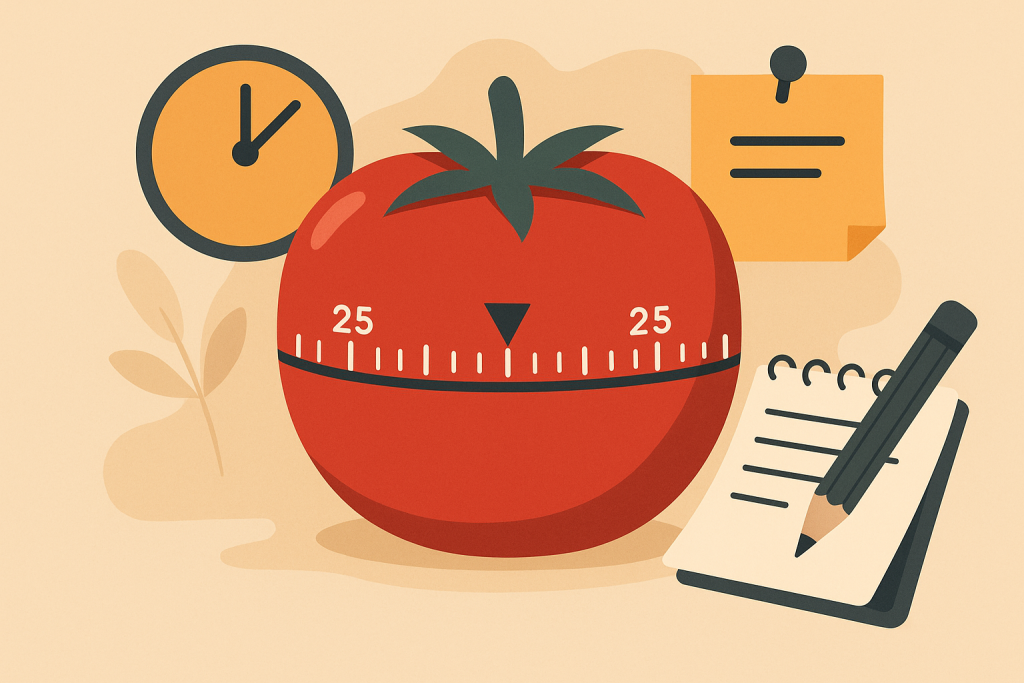How to Use the “Pomodoro Technique” for Better Focus
Emma Brooks June 13, 2025
Do you struggle with distractions or burnout during work or study? The Pomodoro Technique offers a simple yet effective answer: short bursts of focused effort followed by regular breaks. This guide shows how to use the Pomodoro Technique to improve concentration, manage time, and stay motivated in an increasingly distracted world.

What Is the Pomodoro Technique?
Originally developed by Francesco Cirillo in the late 1980s, the method breaks work into fixed intervals—typically 25 minutes—followed by brief pauses. A standard cycle includes:
- Pick a task.
- Work for 25 minutes without interruptions.
- Take a 5-minute break.
- After four cycles, take a longer break (15–30 minutes)
This structured approach helps combat procrastination, improve task management, and limit burnout.
Why the Pomodoro Technique Works
Boosting Focus and Flow
Interruptions can derail productivity for up to 20 minutes. The Pomodoro Technique minimizes such interruptions, enabling deeper concentration and flow—a mental state essential for quality work.
Managing Effort and Mood
A controlled study found that scheduled breaks improve mood and efficiency compared to self-regulated pauses. Short breaks help prevent mental fatigue and keep energy levels balanced throughout the day.
Benefits of Using the Pomodoro Technique
- Improved focus and concentration: Eliminates distractions during timed work periods.
- Better time tracking: Turns work into manageable units, reducing underestimation of task duration.
- Reduced burnout: Regular breaks reset the mind, supporting long-term productivity.
- Enhanced motivation: Each completed Pomodoro delivers a mini win, fueling momentum.
- Flexibility: Easily adapted to different needs—extend or shorten intervals to fit personal focus rhythms.
How to Use the Pomodoro Technique in 6 Steps
- Choose a single task (or small task cluster).
- Set a timer to 25 minutes.
- Work with full focus—no phones, no notifications.
- When time’s up, stop and take a 5-minute break. Stretch, breathe, move.
- Track one Pomodoro, then restart: repeat three more cycles, then…
- Take a longer break (15–30 minutes) to reset fully
During Pomodoros, jot down distractions and address them later outside your focus intervals.
Pomodoro Technique: Tips for Better Implementation
- Adjust intervals if 25 minutes feels too short or long.
- Start with a planning Pomodoro: Use first session to outline your workload.
- Batch similar tasks for efficiency—e.g., emails, research, drafting.
- Use a Pomodoro timer app like Pomofocus, Focus Keeper, or Jibble’s tracker.
- Monitor your progress: Record completed Pomodoros to refine planning and boost motivation.
Where the Pomodoro Technique Shines
Academics & Students
University of Florida studies highlight its benefits for students with ADHD and learning difficulties, improving task initiation and structure . Oregon State emphasizes its role in reducing burnout during exam prep.
Creativity and Writing
Writers use Pomodoro cycles to overcome blocks by working in manageable sprints and taking generative breaks .
Remote Workers & Professionals
Freelancers and knowledge workers gain structure, reduce multitasking, and preserve mental stamina.
Educators & Classrooms
Teachers report better classroom focus and retention when students use Pomodoro periods for timed study and active breaks .
Common Challenges and How to Overcome Them
- Rigidity: Feelings of being constrained are common. Adapt timing to personal rhythm, e.g., 30/10 cycles .
- Interruptions: Use strategies—“inform, negotiate, schedule callback”—to manage external disruptions.
- Task misalignment: For deep work, use longer intervals and group related tasks for continuity .
- Timer pressure: Use gentle digital timers rather than loud alarms to reduce stress during breaks.
Incorporating Pomodoro into Study & Work Culture
- Encourage shared focus periods in teams using synchronized Pomodoros via Slack or Zoom.
- Incorporate Pomodoro training in study skills workshops to boost student wellbeing and productivity.
- Use apps like Forest or Flora to gamify sessions and build focus habits.
Final Thoughts
Learning how to use the Pomodoro Technique empowers you to reclaim attention, structure flow, and prevent burnout. With just a timer and planning habit, you can transform long tasks into achievable sprints, backed by cognitive science. Whether you’re studying, writing, or working, this technique helps you produce consistently without overstretching mentally.
Start today: set a timer, focus hard, break mindfully—and let Pomodoro guide you to sustained focus and better performance.
References
- Cirillo, F. (1987). The Pomodoro Technique https://en.wikipedia.org/wiki/Pomodoro_Technique
- Todoist (2025). Why the Pomodoro Technique works & how to do it https://www.todoist.com/productivity-methods/pomodoro-technique
- University of Florida/Coursera (2024–25). Pomodoro for ADHD and study . https://www.coursera.org/articles/pomodoro-method-study





